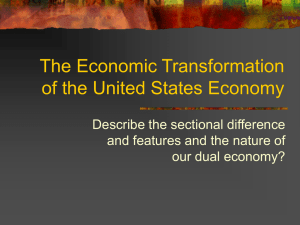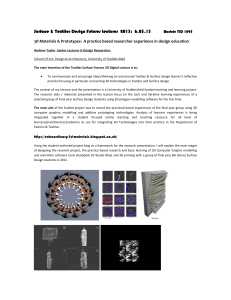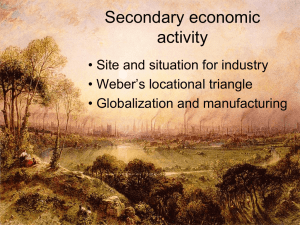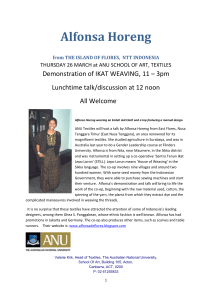Nikhar Gaikwad Yale University, Political Science Department !
advertisement
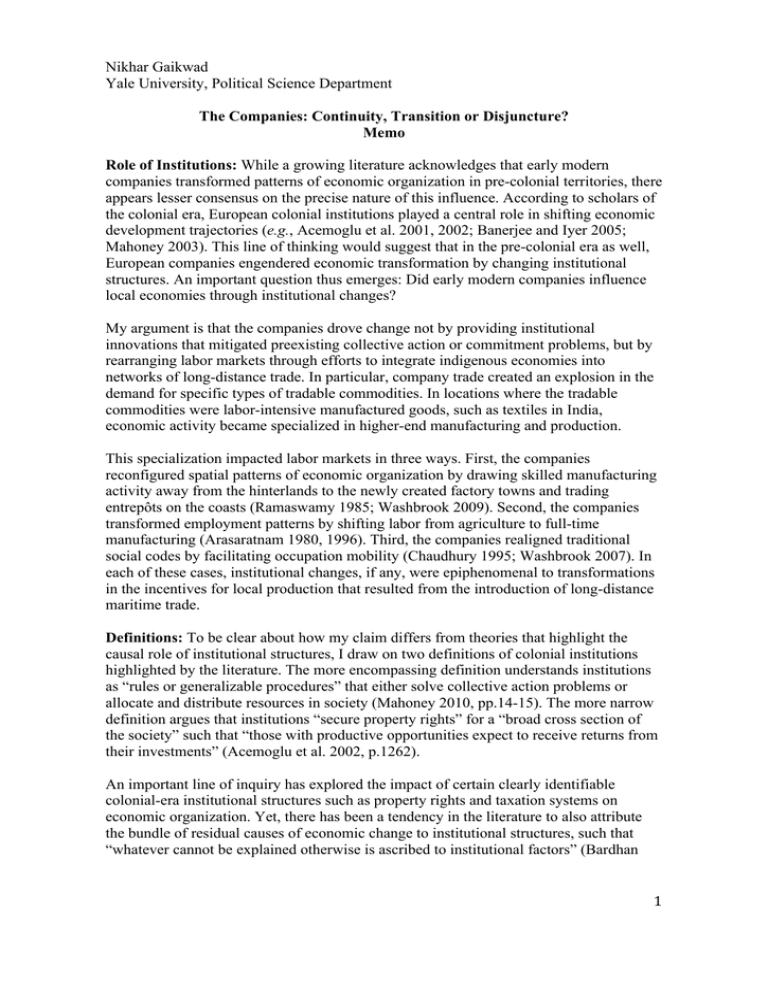
Nikhar Gaikwad Yale University, Political Science Department ! The Companies: Continuity, Transition or Disjuncture? Memo Role of Institutions: While a growing literature acknowledges that early modern companies transformed patterns of economic organization in pre-colonial territories, there appears lesser consensus on the precise nature of this influence. According to scholars of the colonial era, European colonial institutions played a central role in shifting economic development trajectories (e.g., Acemoglu et al. 2001, 2002; Banerjee and Iyer 2005; Mahoney 2003). This line of thinking would suggest that in the pre-colonial era as well, European companies engendered economic transformation by changing institutional structures. An important question thus emerges: Did early modern companies influence local economies through institutional changes? My argument is that the companies drove change not by providing institutional innovations that mitigated preexisting collective action or commitment problems, but by rearranging labor markets through efforts to integrate indigenous economies into networks of long-distance trade. In particular, company trade created an explosion in the demand for specific types of tradable commodities. In locations where the tradable commodities were labor-intensive manufactured goods, such as textiles in India, economic activity became specialized in higher-end manufacturing and production. This specialization impacted labor markets in three ways. First, the companies reconfigured spatial patterns of economic organization by drawing skilled manufacturing activity away from the hinterlands to the newly created factory towns and trading entrepôts on the coasts (Ramaswamy 1985; Washbrook 2009). Second, the companies transformed employment patterns by shifting labor from agriculture to full-time manufacturing (Arasaratnam 1980, 1996). Third, the companies realigned traditional social codes by facilitating occupation mobility (Chaudhury 1995; Washbrook 2007). In each of these cases, institutional changes, if any, were epiphenomenal to transformations in the incentives for local production that resulted from the introduction of long-distance maritime trade. Definitions: To be clear about how my claim differs from theories that highlight the causal role of institutional structures, I draw on two definitions of colonial institutions highlighted by the literature. The more encompassing definition understands institutions as “rules or generalizable procedures” that either solve collective action problems or allocate and distribute resources in society (Mahoney 2010, pp.14-15). The more narrow definition argues that institutions “secure property rights” for a “broad cross section of the society” such that “those with productive opportunities expect to receive returns from their investments” (Acemoglu et al. 2002, p.1262). An important line of inquiry has explored the impact of certain clearly identifiable colonial-era institutional structures such as property rights and taxation systems on economic organization. Yet, there has been a tendency in the literature to also attribute the bundle of residual causes of economic change to institutional structures, such that “whatever cannot be explained otherwise is ascribed to institutional factors” (Bardhan ! 1! Nikhar Gaikwad Yale University, Political Science Department ! 1987, p.1). My argument is that neither of the institutional definitions appears to capture the socio-economic and territorial changes that took place in India during the era of company trade. Evaluating Institutional Mechanisms: As an illustration of this argument, consider the case of advance contracts that were used by many of the early modern companies in India. In order to meet shipping schedules, company traders in India began placing orders with intermediary merchants for hundreds of thousands of pieces of cloth more than a year in advance of delivery dates, through a practice that came to be known as dadni. In turn, merchants began hiring weavers, dyers, bleachers, and printers on a full-time basis to produce pieces of cloth of standardized style and quality (Richards 1993); this was one of the factors that jumpstarted the movement of labor from agriculture to full-time manufacturing. At first glace, the practice of employing advance contracts can be interpreted as a form of nascent institution building, and can suggest that institutional innovations triggered economic transformation during the company-era. Yet this interpretation is misleading because prior to the introduction of long-distance maritime trade, the demand for manufactured textiles was simply not large enough to be able to support full-time employment opportunities for large sections of workers in this industry. It was the surge in European, African, South-East Asian, and American demand for Indian textiles that occurred with the advent of company trade that created the impetus for labor-market transformations in India. Had Indian textiles not become currency in Africa, fashion commodities in Europe, or wage goods in South-East Asia (Riello and Roy 2009), the labor force distribution in agriculture and manufacturing would likely have remained the same. My argument, therefore, is that trading arrangements such as advance contracts flowed from a spike in the demand for manufactured textiles facilitated by company trade, not from institutional efforts to overcome any particular type of commitment or coordination problem. Non-institutional Mechanisms of Influence: As discussed earlier, company trade in specific types of manufactured commodities influenced economic organization in three ways. First, long-distance maritime trade spatially reconfigured regional economies by precipitating the decline of medieval commercial centers and the growth of new trading hubs surrounding the factory settlements of the various companies. Transformations in the textiles industry typify these geographical realignments. Textile production in medieval India was concentrated in temple environs that had large attached cotton growing, spinning, weaving, dyeing, and processing industries (Ramaswamy 1985). With the arrival of long-distance trade, however, the production of textiles shifted away from temple environments in the interior plains and toward the littoral settlements being built by traders. By offering positive inducements, moreover, the companies actively fostered the relocation of skilled labor to manufacturing centers in and around factory settlements. In the early eighteenth century, for example, factory records from Fort St. George (Madras) and Bombay delineate concerted efforts by company agents to attract textile ! 2! Nikhar Gaikwad Yale University, Political Science Department ! manufacturers (Chaudhuri 1996). The erstwhile temple economies, in turn, specialized in agricultural and lower-end production activities to support the urban textile centers. Second, the companies also altered the character of local economic activity by shifting labor from part-time to full-time manufacturing and by enriching a range of occupational groups that were involved in high-skilled production. The English and Dutch companies created over 100,000 new jobs solely within the textile industry of Bengal (Marshall 1987), with the English company investing approximately 400,000 pounds per annum in Bengali goods (Prakash 1985). Apart from textiles, labor-intensive industries such as indigo production and saltpeter manufacturing also burgeoned with the introduction of Indo-European maritime trade. The development of labor-intensive manufacturing industries, as opposed to other types of extractive or resource-intensive industries, gradually shifted workers out of the agriculture sector and into manufacturing industries. Third, company trade reconfigured social structures by subverting the strict social codes that had regulated caste and occupational structures in the medieval temple economies. Because ships had to be loaded quickly before the winds changed, multiple families of different castes began working the same loom over consecutive twenty-four hour periods, often with ‘cleaner’ castes working the day shift and ‘depressed’ castes working the night (Washbrook 2009), practices that would not have been sanctioned in alternate venues because weaving was traditionally a caste-based, hereditary occupation (Chaudhuri 1996; Chaudhury 1995). Likewise, although birth, caste and occupation had been closely regulated in the temple environs, in the newer trading hubs where the demand for labor outpaced reproduction cycles, families frequently resorted to ‘adopting’ members from outside caste groups to quickly increase their numbers (Ramaswamy 1985). These social modifications were important for economic transformation because they generated opportunities for occupational entrepreneurialism. Implications: I have thus far focused on how trade in specific types of manufactured commodities impacted patterns of labor market organization in India. Yet it is worth considering the implications of this argument for other settings as well. It is possible that the effects of company trade and commerce varied across different types of states, local economies, and trading commodities. In studying the historical impact of the slave trade on modern-day economic indicators in Africa, for instance, Nunn (2008) finds a significant negative relationship between trade and economic growth and development. In the Indian subcontinent, pre-colonial European traders confronted state apparatuses that were well-developed and indigenous rulers that had extensive control over local populations. This might have led the companies to engage in different types of trade and commerce compared to commercial activities in other regions. In turn, trade in different types of commodities might potentially have impacted economic outcomes in disparate ways. For example, although the labor-intensive, high-skilled textile trade might have had positive effects on economic organization, the slave trade might have had negative effects. One fascinating avenue for future research is the comparative study of the differential economic impact of company trade in distinctive types of commodities in diverse regions of the world. ! 3! Nikhar Gaikwad Yale University, Political Science Department ! References • • • • • • • • • • • • • • • • • • ! Acemoglu, Daron, Simon Johnson, and James A. Robinson. “The Colonial Origins of Comparative Development: An Empirical Investigation.” American Economic Review 91, 5: (2001) 1369. —. “Reversal of Fortune: Geography and Institutions in the Making of the Modern World Income Distribution.” Quarterly Journal of Economics 117, 4: (2002) 1231–1294. Arasaratnam, S. Cloth and commerce: textiles in colonial India. New Delhi; Thousand Oaks: Sage Publications, 1996. Arasaratnam, Sinnappah. “Weavers, merchants and company: the handloom industry in southeastern India 1750-1790.” Indian Economic and Social History Review 17, 3: (1980) 257–281. Banerjee, Abhijit, and Lakshmi Iyer. “History, Institutions, and Economic Performance: The Legacy of Colonial Land Tenure Systems in India.” American Economic Review 95, 4: (2005) 1190–1213. Bardhan, Pranab. “Alternative Approaches to the Theory of Institutions in Economic Development.” 1987. Mimeo, UC Berkeley: Department of Economics. Chaudhuri, K. N. Cloth and commerce: textiles in colonial India. New Delhi; Thousand Oaks: Sage Publications, 1996. Chaudhury, Sushil. From prosperity to decline: eighteenth century Bengal. New Delhi: Manohar, 1995. Mahoney, James. “Long-Run Development and the Legacy of Colonialism in Spanish America.” American Journal of Sociology 109, 1: (2003) pp.50–106. —. Colonialism and Postcolonial Development: Spanish America in Comparative Perspective. Cambridge: Cambridge University Press, 2010. Marshall, P. J. Bengal: the British bridgehead. Cambridge: Cambridge University Press, 1987. Nunn, Nathan. “The Long-Term Effects of Africa’s Slave Trades.” Quarterly Journal of Economics 123, 1: (2008) 139–175. Prakash, Om. The Dutch East India Company and the economy of Bengal, 16301720. Princeton, N.J.: Princeton University Press, 1985. Ramaswamy, Vijaya. Textiles and Weavers in Medieval South India. Delhi: Oxford University Press, 1985. Richards, John F. The new Cambridge history of India, The Mughal Empire. Cambridge: Cambridge University Press, 1993. Riello, Giorgio, and Tirthankar Roy. How India clothed the world: the world of South Asian textiles, 1500-1850. Leiden; Boston: Brill, 2009. Washbrook, D. “India in the early modern world economy: modes of production, reproduction and exchange.” Journal of Global History 2, 1: (2007) 87–111. Washbrook, David. How India clothed the world: the world of South Asian textiles, 1500- 1850. Leiden; Boston: Brill, 2009. 4!
